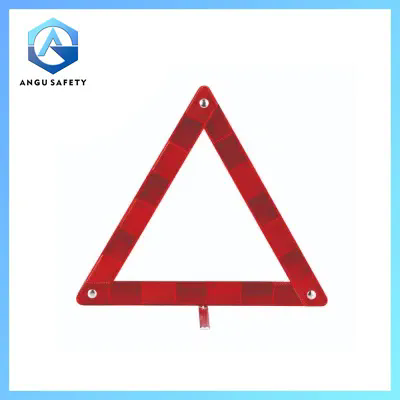Understanding Emergency Triangle Reflectors: Your Questions Answered
2024-11-04
Emergency triangle reflectors are essential safety tools for drivers, especially during roadside emergencies. These reflectors help increase visibility and alert other motorists to potential hazards. In this Q&A blog, we’ll address some common questions regarding emergency triangle reflectors, their usage, and their importance in road safety.
What are emergency triangle reflectors?
Emergency triangle reflectors are portable safety devices designed to warn other drivers of a vehicle that has broken down or is otherwise stopped on the side of the road. Typically triangular in shape and equipped with reflective surfaces, these devices are meant to enhance visibility in low-light conditions, such as at night or during bad weather.
Why are emergency triangle reflectors important?
Emergency triangle reflectors are crucial for several reasons:
1. Increased Visibility: They make stopped vehicles more visible to oncoming traffic, reducing the risk of collisions.
2. Alert Other Drivers: The reflective nature of the triangles helps catch the attention of other motorists, alerting them to the potential hazard ahead.
3. Safety: Using reflectors can significantly enhance the safety of both the stranded driver and other road users, especially in low-visibility situations.
4. Legal Requirement: In many places, carrying emergency triangle reflectors in vehicles is a legal requirement, particularly in commercial vehicles.
How do you use emergency triangle reflectors?
To properly use emergency triangle reflectors, follow these steps:
1. Ensure Safety First: If your vehicle breaks down, safely pull over to the side of the road, away from traffic. Turn on your hazard lights to alert other drivers.
2. Set Up the Reflectors: Remove the triangles from their carrying case and set them up at appropriate distances from your vehicle. Place one triangle about 10 feet behind your vehicle and another 10 feet in front. If you are on a highway, it’s advisable to place them further back—approximately 50 to 100 feet—depending on the speed limit of the road.
3. Make Sure They Are Visible: Ensure that the triangles are clearly visible to oncoming traffic. The reflective surfaces should face the direction from which vehicles will be approaching.
4. Follow Local Guidelines: Different regions may have specific regulations about the placement and usage of emergency triangles, so it’s important to be aware of local laws.
What are the features to look for in a quality emergency triangle reflector?
When choosing emergency triangle reflectors, consider the following features:
1. Reflective Material: Look for high-quality reflective surfaces that provide maximum visibility during both day and night.
2. Stability: Triangles should be sturdy and capable of standing on their own without falling over, even in windy conditions.
3. Ease of Use: Opt for reflectors that are easy to set up and dismantle, ideally with a carrying case for convenience.
4. Durability: Choose reflectors made from weather-resistant materials to ensure they can withstand various environmental conditions.
5. Compliance with Regulations: Check if the reflectors meet the safety standards and regulations in your region.
Are there any alternatives to emergency triangle reflectors?
While emergency triangle reflectors are a widely recognized safety tool, there are alternatives that can also enhance roadside safety:
1. Flares: Traditional flares can provide a bright signal, but they should be used with caution due to fire hazards.
2. LED Road Flares: These battery-operated flares are safer than traditional flares and offer bright, flashing lights to alert motorists.
3. Safety Cones: Brightly colored safety cones can also serve to warn drivers but may not have reflective properties like triangles.
4. Warning Lights: Portable LED warning lights can be set up to provide a flashing signal to alert oncoming traffic.
Each of these alternatives has its advantages and should be chosen based on specific needs and regulations.
How can I ensure my emergency triangle reflectors are in good condition?
Regularly check your emergency triangle reflectors to ensure they are in good working order:
1. Inspect the Reflective Surface: Ensure the reflective material is not damaged, dirty, or worn out. Clean them if necessary to maintain visibility.
2. Check Stability: Make sure the triangles can stand upright and do not have any broken parts.
3. Store Properly: Keep the reflectors in an easily accessible location within your vehicle, preferably in a protective case to prevent damage.
4. Replace When Needed: If your reflectors show signs of significant wear or damage, replace them to ensure maximum safety.
Are there any legal requirements for using emergency triangle reflectors?
Yes, many regions have legal requirements regarding the use of emergency triangle reflectors, particularly in commercial vehicles. These regulations may specify:
- The number of reflectors required to be carried in a vehicle.
- Specific placement distances from the vehicle.
- Compliance with safety standards.
It is important to check local laws and regulations to ensure compliance and enhance safety on the road.
Conclusion:
Emergency triangle reflectors are essential safety devices that can significantly reduce the risk of accidents during roadside emergencies. By understanding their importance, usage, and maintenance, drivers can ensure they are well-prepared for any unexpected situations on the road. Always carry quality emergency triangle reflectors in your vehicle, and use them effectively to promote safety for yourself and other motorists.



